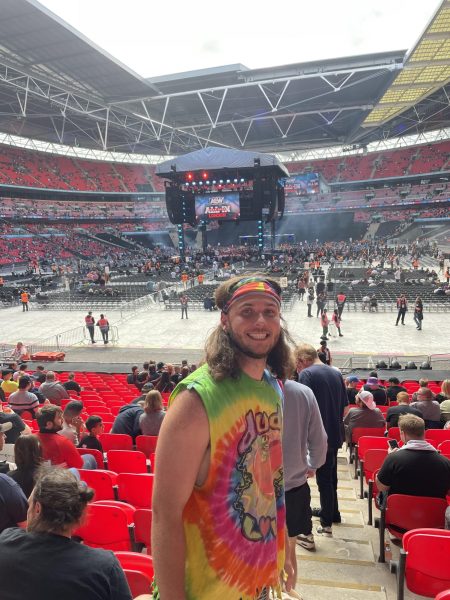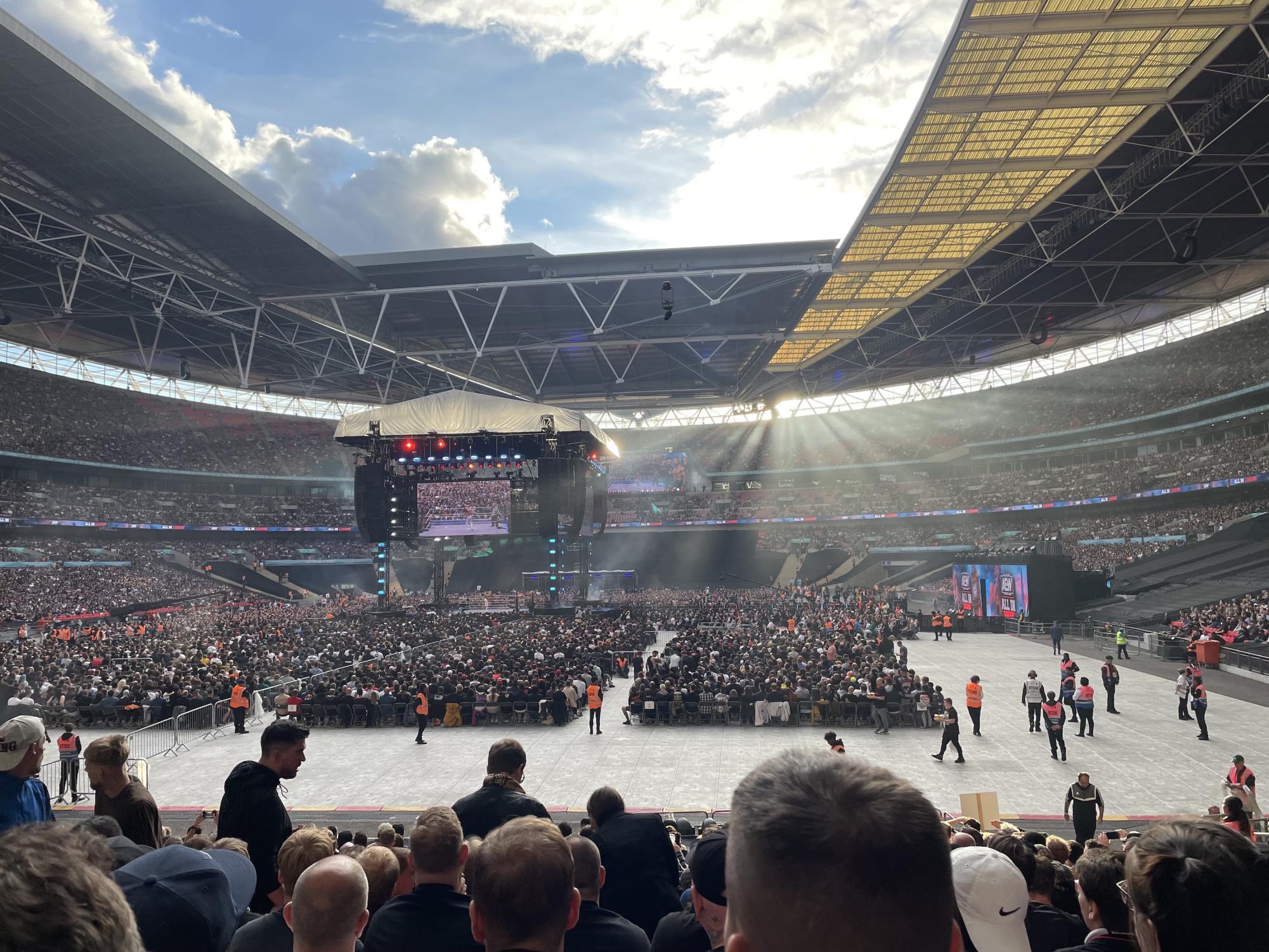On a warm night in London this summer, an estimated 80,000 wrestling fans packed into Wembley Stadium, setting the record for paid attendance in the history of professional wrestling.
Less than five years before the show, in November 2018, the sport had hit rock bottom, when four wrestling legends competed at World Wrestling Entertainment’s Crown Jewel show in Saudi Arabia.
In what can only be described as one of the worst pay-per-view matches in the WWE’s storied history, Shawn Michaels and Triple H faced the Brothers of Destruction, the Undertaker and Kane.
During WWE’s “attitude era” of the 1990s, these four wrestlers were some of the sport’s most important competitors, largely responsible for bringing in an average of 5 million weekly viewers in 2001 to Raw, WWE’s flagship show. However, by the time of the November 2018 match, the four men were much too old to be wrestling. For nearly half an hour, they bumped around the ring at a snail’s pace, barely pulling off their signature moves.
In the 17 years since 2001, WWE’s viewership had dropped by nearly 67%.
At the same time, WWE was facing significant problems outside the ring, including criticism for its decision to hold the show in Saudi Arabia just a month after 15 Saudi agents killed Washington Post journalist Jamal Khashoggi in Turkey.
This criticism is known as “sportswashing,” the use of investments in sports to improve the reputation of a country, company or individual. Saudi Arabia, an oil-rich nation with a shoddy human rights record, has become one of the biggest sportswashers in the world. This July, the Guardian reported that the country has spent $6.3 billion on sports since 2021 through various investment funds, four times the amount it spent in the six years before.
Luckily for fans, a wrestling renaissance was on the horizon. Only two short months after WWE’s disastrous Crown Jewel contest, All Elite Wrestling, commonly known by its acronym, AEW, was launched.
American businessman Tony Khan, together with his billionaire father Shahid Khan, founded the alternative to WWE off the back of an independent show called “All In” in September of 2018. The show featured some of the biggest free agent stars in wrestling and drew in 11,263 fans — the largest non-WWE crowd since 1993 — to the United Center in Chicago. The show sold out in less than 30 minutes and the Khans were quick to use that momentum and fan interest to create a wrestling promotion and get it on TV.
For the first time in decades, WWE had a legitimate competitor on cable television. Like World Championship Wrestling in the 1980s and ‘90s, this competition led to a jump in TV ratings, live attendance, mainstream appeal and earnings for performers.
AEW introduced its first television show, “Dynamite,” in October 2019, four months after announcing a deal with Warner Media to put its weekly show on TNT on Wednesday nights. Shortly after, WWE moved their developmental show, NXT, to those very same Wednesday nights, believing they could kill AEW.
This marked the first time two major wrestling shows had gone head-to-head on the same night and time slot since 2001. “Dynamite” slowly but surely drew viewers away from NXT. Less than two years later, NXT was forced to move to Tuesday nights on the USA Network when the NBC Sports Network shut down. WWE never admitted that the ratings decline played a factor in the scheduling change, but it was clear to fans who followed both companies that it was beneficial to both shows for them to have their own time slots.
This battle over ratings became known as the Wednesday Night Wars; Brandon Thurston of Wrestlenomics documented the differences in the ratings of both shows and which key demographics AEW was winning.
“AEW dominated with younger viewers,” Thurston wrote, “[in the 18 to 49 year old demographic], AEW led on 74 of the 75 nights.” With NXT moving to Tuesday nights, the ratings and interest in both shows only increased. Fans who wanted to be able to watch both shows now could easily do so.
Renewed competition led to other benefits as well.
For the past 18 years or so, WWE had acted as a monopoly, buying out and ending competitor’s promotions, ultimately hurting the industry as a whole, with only WWE profiting monetarily.
This business strategy was largely of Vince McMahon’s volition. Serving as the CEO and chairman of WWE for decades, McMahon played a leading role in bringing professional wrestling to prominence. However, he also helped to crush WWE’s competitors while pursuing a vision of professional wrestling where one company covered the whole country and was the center of attention, rather than allowing various promoters to occupy different regions of the country.
The return of corporate competition has benefited fans and wrestlers alike.
Since AEW started broadcasting in 2019, the company has added two more shows, one on Friday and one on Saturday, named “Rampage” and “Collision” respectively. Combined with WWE, there is now at least 12 hours of professional wrestling every week on major cable TV, the most in the industry’s history. So far in 2023, an average of 6.5 million viewers tuned in each week–-the highest viewership in more than 20 years.
Competition has also led to higher salaries and more favorable deals for talents. Not only have wrestlers earned more, but they’ve been able to move from company to company and negotiate better deals for themselves. Huge names like Cody Rhodes, Adam Copeland and Jade Cargill have successfully leveraged the other company and signed with the competitors to get more money and more opportunities to be on television.
With a rise in interest on television, this has also been a record year in live attendance.
AEW started to gain momentum at the start of this summer, in large part due to the unlikely on-screen friendship between top stars Adam Cole and AEW World Champion Maxwell Jacob Friedman. The two became fan favorites with their weekly skits on “Dynamite” as well as becoming tag team champions of sister promotion Ring of Honor.

The addition of “Collision” on Saturday nights gave AEW more TV time to tell even more stories as they started to gear up for their upcoming pay-per-view at London’s legendary Wembley Stadium. The show’s card featured a rare match from the icon Sting and a showdown between multi-time world champion Chris Jericho and young phenom Will Ospreay, which proved to drum up more than enough excitement to nearly fill the over 90,000 capacity stadium on Aug. 27.
At the show, commentator Nigel McGuinness claimed that AEW sold 81,035 tickets at Wembley Stadium in London for the second ever “All In” event. (Though turnstile entries only counted 72,265 people admitted to the event, it was still by far the largest paid show for a non-WWE event.)
Speaking at a post-show press conference, Tony Khan said, “The original ‘All In’ five years ago was the largest independent pro wrestling show of all time. Today… AEW ‘All In’ is the biggest pro wrestling show of all time period.”
WWE has also had significant success in live attendance in 2023, mostly due to top champion Roman Reigns and his “Bloodline” storyline, which saw Reigns turn heel to embrace a darker side of his character and stake his claim as the tribal chief of the Anoa’i family, whose most famous member is none other than The Rock. This, coupled with captivating stars like LA Knight and Rhea Ripley, and the new creative direction of Paul Levesque–AKA Triple H–has led WWE to break dozens of its own records in live attendance at venues across the country, with press releases announcing each new record as well as record quarterly earnings in 2023.
Much like AEW, WWE also made an effort to tap the international markets, running extremely successful shows in Scotland and Puerto Rico for the first time in the promotion’s history, with shows in Berlin and Paris tentatively scheduled for 2024.
2023 saw growth in the professional wrestling business for the first time in more than 20 years. While business growth and monetary value is important, the real winners of the competition between WWE and AEW are the fans who love this art form and the performers who make it all possible. Giving fans an alternative to WWE has proven to be the answer to what only a few years ago seemed to be a dying industry. But this time the competition is too big to fail.





